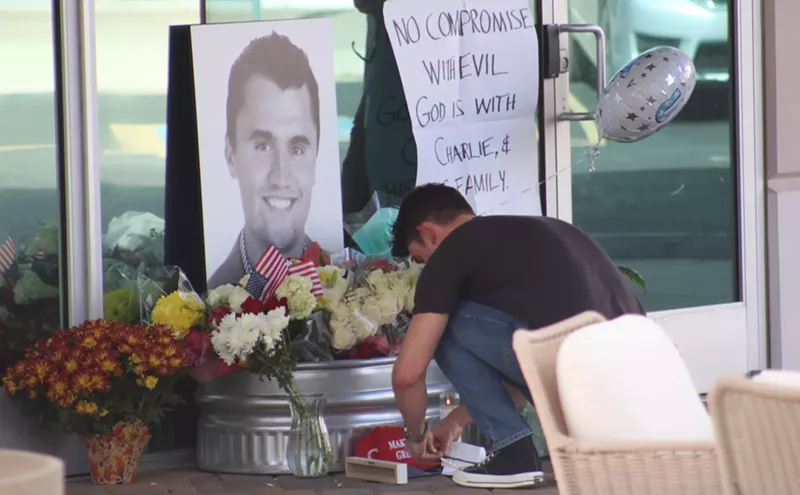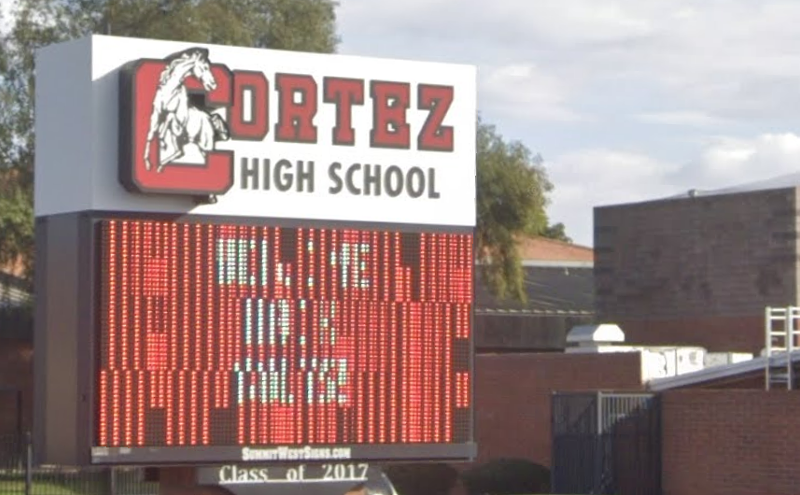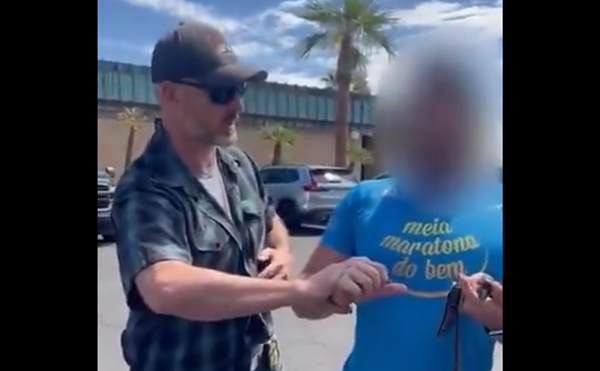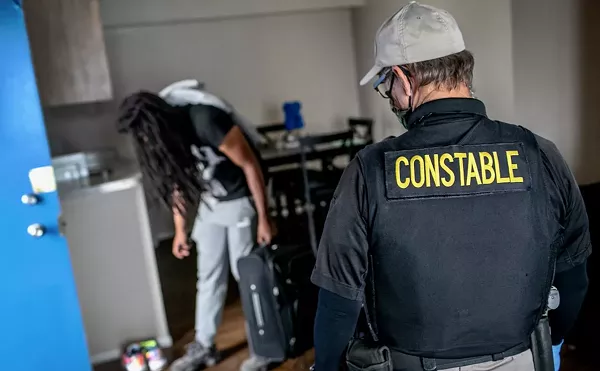About six years ago, a brilliant and troubled soul named Chris Shelton came to realize that methamphetamine was going to kill him.
In 1998, psychologists had diagnosed Shelton with a serious mental illness called "schizoaffective disorder," which causes periods of losing touch with reality and crippling mood problems, including severe depression.
That came as no surprise to the Phoenix man, now 43, who concedes that he had been teetering for years. He couldn't hold a job anymore, couldn't stop his mind from racing, and was living one precarious step from the streets.
"When they told me I was SMI [seriously mentally ill], it wasn't like they were saying I had won the lottery," Shelton says. "That's when I officially became one of 'those' people. It was like getting a stamp that said my brain was officially damaged, or whatever you want to call it."
Shelton doesn't appear different from anyone else: He's a nerdy-looking white man who favors well-worn golf shirts and khakis, and seems about as menacing as a friendly, if somewhat wary, dog.
Even when he was doing meth — a drug that can turn milquetoasts into pit bulls — Shelton says he steered clear of the law.
"How did I stay out of trouble? I did not go anywhere or visit anyone," he says. "[A friend] has the best answer. 'You were a speed freak, not a tweaker. A speed freak is an addict. A tweaker steals for the drug.' I never stole and would go days without eating and sleeping."
Shelton doesn't "act crazy," "out of control," "dangerous," or any other phrase often used to describe those who suffer from serious mental illness.
Probably his most off-putting characteristic is his tendency to speak loudly when he gets excited. Inevitably, he apologizes afterward.
"Most of us are a lot like me," Shelton says, the "us" referring to people with mental-health issues. "We are not Jared Laughner. We get hurt a lot more than we hurt. We may be angry and upset about our lives, but we don't take guns and shoot innocent people any more than the 'normal' population does. I'm pretty sure we hardly ever hurt anyone but ourselves."
For sure, the Chris Sheltons of the world rarely make the news, even when they die at someone else's hands.
Shelton says he convinced himself at one point that his life was destined to spiral downward until it ended, which he strongly suspected would be sooner rather than later. His descent into the meth netherworld was an inevitable step along that road to oblivion.
"I have had a lot of anger and rage inside of me and around me," he says, "and I've tried different ways of [dealing] with it, some of them pretty stupid. I just have this mania."
Shelton has written poetry on and off for years, though he calls most of his efforts "lame."
Some — including rowdy limericks about Sheriff Joe Arpaio (Shelton's no fan) — are lighthearted.
Others, such as a self-portrait of his life titled Mental Abuse, are dark:
Knives are understandable
They cut you
Mental abuse isn't understandable
It cuts you but yet it is not visible
If a person is cut on the outside
They are bandaged with tender loving care
If a person is cut on the inside
They aren't bandaged — they are told that the wound is not 'real'
But in 2005, Shelton says, he caught a couple of breaks.
The first was when he decided to heed the words of a young Phoenix woman, a close friend he will identify only as "my guardian angel."
She told Shelton that a tragic end was coming if he didn't quit messing with meth.
"She was a one-person intervention," he says. "She is very loving but can be tough if she is mad." Also around that time, Shelton joined an old pal, John Neal, for a rare night out at the Rhythm Room on East Indian School Road (both are Phoenix Central High School, class of 1983, alumni). A topic of conversation at the club veered at one point to Daniel Mendoza, a late-18th-century British boxing champion who wrote the pioneering book The Art of Boxing, and to another old-time bare-knuckle prizefighter, celebrated American ex-slave Thomas Molineaux.
Shelton is both a lifelong history buff and a boxing fan.
"I worked on boxing research all the time when I did meth," he says, "but I did it purely as a hobby. I would watch videos of [boxing greats] Jack Johnson, Jack Dempsey, Gene Tunney, Muhammad Ali, 'Jersey' Joe Walcott, Ezzard Charles . . . and would write down what was happening in the ring punch-per-punch."
That night at the club, Shelton says, "Something hit me. I guess I decided to become a boxing historian, to do real research and see where it went. It was a 'moment.'"
Remarkably, that moment has evolved into a passion.
These days, Shelton "self-medicates" by doing serious research on boxers, especially those "sweet scientists" who toiled in the 18th and 19th centuries.
"I actually don't miss meth one bit, honestly," he says. "My mind is wild enough as it is."
Shelton is making his mark in the arcane world of boxing research, an arena where self-described "historians" too often parrot long-held beliefs about fighters and fights without doing due diligence.
To the contrary, Shelton hardly is one to regurgitate mainstream thinking about anything — he does his own legwork, a time-consuming, sometimes frustrating, task with no financial gain. He bristles, as an example, at the legions of boxing writers who repeat what he says are unsubstantiated accounts of the 29th round of the storied 1810 fight in London between white British champion Tom Cribb and Tom "The Black" Molineaux.
"I have an edge over a lot of researchers because I still use the library system and not just the Internet," he says. "It's just a matter of doing your homework and not believing what you read in Wikipedia, which is wrong about just about everything."
Boxing websites have been publishing his colorful and deeply researched articles for a few years.
"Chris is an outstanding researcher who has similar views to [mine] in that he goes back and does the homework and knows that, as a historian, you can't trust everything that's come before," says Tracy Callis, a member of the International Boxing Research Organization (IBRO) and director of historical research at the respected cyberboxingzone.com website.
"The farther back you go, the harder it is to get to the truth, but Chris never takes the easy way, like so many folks, and rewrites someone else's work," says the Roanoke, Virginia, resident. "The hours he has to put in are impressive. I don't know much about his life, other than I understand he hasn't had it easy. All I do know is that he is an outstanding gentleman, honest, and a huge addition to our work."
Shelton doesn't just pore over microfiche of old newspapers and surf the Net in search of information, legitimate or otherwise. He has conducted several interviews in the past few years, some with descendants of his subjects (a 2009 chat with the 90-year-old daughter of welterweight champ Jack Britton is one delightful example).
His interview technique is natural and disarming: He lets his subjects know up front that he's done his homework, and then gets out of the way, allowing characters such as onetime Phoenix amateur pugilist Bill Thompson ("Wallace" of Wallace & Ladmo fame), late local promoter/manager Al Fenn (who managed Chandler resident Zora Folley, one of the Valley's greatest all-time boxers), and others tell their stories.
Shelton also appears on Internet radio shows to discuss boxing and boxers, ancient and modern.
In May, he was interviewed by Dennis Taylor, whose weekly show (with co-host Joe O'Rourke) from Monterey, California, airs on ringsideboxingshow.com and an area AM radio station. Shelton chatted easily about famed lawman Wyatt Earp and a wildly controversial 1896 bout in San Francisco that caused Earp almost as much grief as that little spat in Tombstone back in 1881 known as the Shootout at the O.K. Corral.
Radio host Taylor, who has a regular gig as a journalist for Monterey's daily newspaper, introduced Shelton this way:
"He is such a meticulous historian. He drives himself absolutely crazy. The toothpick doesn't go all the way through the hot dog with this guy. If he cannot verify things, he doesn't consider it history — basically he finds all kinds of mistakes in history."
Earlier, Shelton had penned a piece for cyberboxingzone.com about Earp's role in the prizefight that pitted two of the best heavyweights in the world, "Sailor" Tom Sharkey and Bob Fitzsimmons.
Shelton spent months scrutinizing the fight through materials he found with the assistance of the Library of Congress, the San Francisco Public Library, and other resources. The national library shipped microfiche of yellowed newspapers and other pertinent historical materials to Phoenix for Shelton to study (he was allowed to peruse the data at the Burton Barr Library).
By 1896, Earp's gunslinger days in Arizona were long past him, and he was living comfortably in San Francisco when, curiously, the fight's promoter asked him to serve as the referee for the 10-round fight.
Sharkey was a decided underdog, and Fitzsimmons knocked him out in the eighth round after punishing him with body shots for much of the fight — described in excruciating detail by the many sportswriters who were there.
But Earp awarded the decision to Sharkey (who was on the canvas, either unconscious or feigning to be) because of an alleged low blow by Fitzsimmons, as an estimated 15,000 spectators hooted their disapproval.
The fight and its aftermath made front-page news for days, with what later became known as "team coverage" in the San Francisco Chronicle and other papers.
Shelton's conclusion: Earp conspired with Sharkey's people to steal the championship from Fitzsimmons in return for a secret 25 percent cut of the winnings, or $2,500.
Safe to say, not all the historians are on the same page as Shelton, which doesn't faze him in the slightest.
"I don't care where the information takes me," he says. "I just want it to take me somewhere where I'm comfortable saying, 'This is what happened and I can prove it.' I did that in the Earp case, and in every other story I've done. I don't write anything that I can't back up."
While doing his Sharkey-Fitzsimmons research, Shelton uncovered a letter that Earp wrote in 1909 to old Tombstone pal Bat Masterson —another legendary Wild West figure who improbably spent the final three decades of his life as a sportswriter. Earp insisted that he never would have thrown the San Francisco fight for money because he was flush at the time.
"At the time of the Fitzsimmons-Sharkey fight, I owned and raced a stable of thoroughbreds on the tracks at Oakland and Ingleside," Earp told his old associate. "Take my tip, Bat, and never referee a prizefight. It's a thankless job, and you're sure to make enemies no matter how fairly and honestly you may act."
Chris Shelton doesn't buy it.
Dennis Taylor of ringsideboxingshow.com says he holds Shelton's research abilities in high esteem.
"His passion and obvious enthusiasm for history makes it entertaining for us and for the audience," Taylor says. "With boxing stories, you hear them a million times, and you tend to accept them as true. Christopher doesn't take anything at face value, which makes him somewhat unique as a boxing historian. Unique is actually a good word to use to describe him as a person, and I mean that in a good way."
This is not the story of a man who "beat" serious mental illness.
Yes, Chris Shelton has found an unlikely niche in this life by immersing himself in the nuances of boxing antiquity.
But Shelton's substantial day-to-day problems are not about to vanish because of vigorous intellectual activity and attention to minute historical detail.
He has to check in regularly with his caseworkers at Magellan Health Services, the firm that contracts with Maricopa County to provide behavioral-health services for thousands of local residents. He goes on and off psychotropic drugs, saying, "I don't like being a zombie — being numb to things — the weight gain, the sleep problems. It's not a win-win situation for me."
Shelton tries to make do on about $600 a month in disability income provided by the state of Arizona. The government pays two-thirds of his rent because of his mental disabilities, and he remits the remaining $192, which leaves him with about $100 a week to cover the rest of his needs.
He eats many of his meals for free at a nonprofit day center called CHEEERS (yes, with three Es). Near 19th Avenue and Indian School Road, the center also provides the seriously mentally ill with a safe haven, self-help programs, a computer with a working web connection, and a nice pool table.
CHEEERS is funded mostly by a contract with Magellan.
Shelton lives in disarray at a west Phoenix apartment complex that won't be featured in Better Homes and Gardens. Actually, his funky second-floor unit would be a better fit on an episode of Hoarders.
Shelton spends hours there squatting in front of his laptop computer (a gift from friends) on his living-room floor. The Internet connection at the complex is sporadic, which frustrates him endlessly.
Several large cardboard boxes that are overflowing with his boxing research, books, and memorabilia dominate the living-room décor.
The word "messy" is a gross understatement, yet Shelton's apartment is devoid of furniture, other than one rickety lawn chair. He sleeps (though not much, he says) on a floor mat in what passes as a bedroom.
"This isn't exactly living the good life," Shelton says, "but it's my life."
He is a gracious host, happy for the company and the opportunity to discuss boxing history.
"It's what keeps me going," he says. "This thought has grown in me that you have to have a goal and a dream, and that sometimes it takes years to get there."
Those precise goals and dreams are difficult for Shelton to define.
"You remember The Truman Show?" he asks, referring to the existential Jim Carrey movie about an ordinary guy who discovers that he's a prop in a popular reality-TV show, and subsequently tries to escape into the "real" world.
"I can relate to the Carrey character, who wants to open that door and sneak out and face a real future, no matter what it brings. I am more than just some diagnosis. I can have a life, too."
Shelton is quietly proud that he has turned himself into a legitimate boxing historian — a contender, if you will — with a sense of purpose that had eluded him for a lifetime.
Still, his day-to-day struggle remains lonely and difficult.
Chris Shelton answers directly when asked whom he counts on most in his life.
"I have the most interesting support system you can imagine," he says. "I have people out there who want the best for me. I know that."
First, he names a young woman he describes as his "sister," a medical student from Turkey named Ceren Sultan Altay, whom he befriended on Facebook several years ago.
(Ceren seems to be a real person. She sent New Times an e-mail, writing, "I never accept 'friend' requests from strangers, but Chris had sent me a kind message and asked me about Turkish rock groups. Then, we started to talk about Turkish rock singers, bands. I realized that Chris knows lots of things, and I wanted to benefit his experiences. We shared many things with each other. We know our lives deeply. We have never seen each other, but he is the biggest supporter of me. When I am about to give up, he immediately makes me refocus on the things I have to do. When I go into some difficulties, I just share [them] with Chris because he also shares some points of his life and says, 'Tomorrow, you start again. Never give up!' I'm a strong girl standing on her feet, but sometimes I need a stronger person to be supported by . . . Chris is a saver and supporter for me.")
Shelton also speaks well of two Parisian women, artists Stephanie Venerande and Sabrina Helene, also Facebook pals he never has met in person but says he relies on for emotional support.
His list of supporters includes his "guardian angel," the very private Phoenix woman who, he says, forcefully urged him to quit meth in 2005.
"I can tell you she ended our friendship as part of her intervention," Shelton says. "She has never officially become friends again, but three years ago, she began guiding me to hang in there and continues to do this today."
Finally, there is Queenie, a black Labrador retriever whose Central Phoenix owner is a former neighbor of Shelton's.
"I know — the crazy guy who says a dog is part of his support system," he says. "But Queenie loves me unconditionally."
Shelton is less enthusiastic about his actual family.
"I love my mother, but I'd rather not talk about them," he says. "I try to move forward, not backward."
As for in-the-flesh friends, Shelton says he has longtime pals who often come through for him — John Neal (the Rhythm Room guy) and wife Laura and another school friend, Phil Hodesh, immediately come to his mind.
Says Hodesh, "Chris is a very intelligent and funny guy who happens to get very obsessive about things, to put it mildly. He has problems just like the rest of us, but so what? He would never hurt anyone and has a lot to offer this world. It hasn't been an easy ride for him."
Born in California as the youngest of three brothers, Chris Shelton moved with his divorced mom to Phoenix when he was in second grade. He is of Mexican and Irish descent.
His mother, Carroll Roarty, who now lives in Bullhead City, says, "Chris always had idiosyncrasies — he didn't eat baby food or, later, he'd go to school wearing a coat in hot weather — but he was a smart kid. Or was I so non-observant? It makes me so upset that the DNA cocktail that his father and I gave him has left him in such a struggle."
Shelton went to Solano Elementary School, south of Christown Mall near the Yucca Public Library.
"I have known that library since 1973," he says. "I love libraries. Being in a library is where I do some of my best thinking."
Shelton later attended Central High, where he says he was an honor student and occasionally even took tests for other students — for a few bucks.
"I think I was a regular kid in most ways, and I wasn't the worst-looking guy in class," he says. "But I just couldn't get a girl to go out with me. I didn't know what to do. I felt different than pretty much everyone else."
So, surely, did many of his adolescent peers.
But it went way beyond that for Shelton. He says he left home for good a week after graduating from high school — "My stepfather kicked me out," he says — and he moved to Southern California, where he stayed for years with his paternal grandmother.
A Los Angeles-area law firm hired him to do clerical work. He says he did well there for a few years before taking a job as a waiter at UCLA's faculty restaurant, where he served such luminaries as Eddie Murphy, John Lithgow, and basketball's James Worthy.
"They all knew my name," Shelton says.
He quit the restaurant job in the mid-1990s and moved to San Ysidro, at the southern tip of San Diego, where he found work, but only briefly, at a sandwich shop. By then, Shelton says he was suffering uncontrollable tremors and was having racing thoughts that made it difficult for him to sleep or to think clearly.
"I was having a really tough time," he says, which sounds like an understatement.
Shelton says he moved across the border to Tijuana for a few months. He says he loved it, even though his money situation was grim and his mental situation was getting worse.
He returned to Phoenix in the late 1990s.
His mother says she did her best to help him.
"When someone is mentally ill in your family, it's so hard to know what to do," Carroll Roarty says. "Chris is a good person, a gentle person who has a harder time in life than most of the rest of us. It just tugs at your heartstrings. When it came to trying to get a job back in Phoenix, he couldn't get one. He tried, he really did. But this is his life, and I tried to be there for him."
She paid the rent for his apartment for a time (this was before he officially qualified for disability income) and gave him $20 a week in spending money.
But his mental illness was getting the better of him.
"Eventually, I took a psychological test," he says. "They asked me if I had bad thoughts against the government, stuff like that. They told me I was mentally imbalanced and wouldn't be able to work anymore, that I was SMI. I felt like I had leukemia."
Shelton says he sometimes didn't have enough money to eat in those first difficult years after he returned to Phoenix. Some days, he recalls, he had only enough money for one hot dog from Circle K: "I'd load it up with lots of peppers and whatever else they had, because that was it, food-wise."
It was during this time that he fell prey to methamphetamine, which wreaks havoc on even the most stable of minds.
"Meth is a bad, bad drug, and for a guy like me, just no way," he says. "A part of me knew, or at least hoped, there was something for me out there. I just didn't know what it was."
Of all things, "it" turned out to be researching, writing, and talking about the lives and times of old-time prizefighters.
In recent months, Chris Shelton has been examining the lives and times of a slew of new subjects.
He is looking into the fascinating Elizabeth Wilkes Stokes, an early-18th-century British woman who professionally fought other women and men with her fists and deadly weapons such as swords and knives, all while wearing a long dress. Stokes, Shelton says, would have fit in with today's MMA (mixed martial arts) crew currently stealing much of boxing's fan base.
He also is in the early stages of a study of African-American heavyweight American boxers during the 1880s, most of them Chicago-based.
Perhaps his most profound effort has been to dissect the life and boxing career of Tom Molineaux (1784-1818), a compelling character who would make a perfect subject for a full-length feature film.
Billy Cologero, another boxing historian and the host of an Internet boxing show, talkinboxing.com, says Molineaux was Mike Tyson about two centuries before Mike Tyson was born. Unlike Tyson, though, he didn't live long. A charismatic and somewhat terrifying prizefighter who scaled the top of his sport, he endured the hardest of falls and died at a young age.
Cologero, of Lake George, New York, recently finished writing a book about Molineaux titled From Slavery to the Baddest Man on the Planet, which he is self-publishing after what he says has been six years of research and writing. He repeats mainstream views about Molineaux's origins, that the heavyweight was a slave at a Virginia plantation before being freed and going onto great fame, if not riches.
But Chris Shelton's own research has told him something different, that Molineaux was from Maryland or New York, not Virginia.
Disagreements such as these are not unusual for historians, though for Shelton it is a personal matter.
"I hear, 'What difference does it make where someone was from or what exact date did they fight someone and so on?'" Shelton says.
"To me, it is not just boxing history, but African-American history and American history, so it makes me unhappy that the untruth has so much power. Everything I would have written about Tom Molineaux before I did my own research would have been wrong. It just bothers me when people spend a little time on Google and write something up like they have really done their legwork — it's just wrong."
Shelton is unlikely to make much, if any, money as a boxing researcher.
More unfortunately, his existence in Arizona, a cruel state where devastating cutbacks in services for the poor and disabled are a recurring story, is bound to remain a monumental task.
For now, however, Shelton still has his beloved public library (though hours are getting cut back there, too), his myriad writing projects, his refuge at CHEEERS, and his unique focus.
"For me, a great day of research is to find a bout that has been forgotten for more than a century," he says. "I have recently discovered George Godfrey [a superior Canadian heavyweight slugger] fights from the 1880s that were lost for more than a century. This is thrilling for me. I look at it as an archeological treasure hunt. It is strange to have a discovery and briefly be the only one who knows about it.
"I remember when I began putting the puzzle pieces together of the 1720s English boxing scene. It was tough. I began with a few pieces. Then you find more, but they do not fit together. Then you find one or two more pieces. You read the small print in old, old newspapers until your eyes get blurry. You have an idea of where things might go, but they do not fit. Then the pieces finally come together. Not always, but when they do, it is a tremendous relief. It is a feeling like no other."












